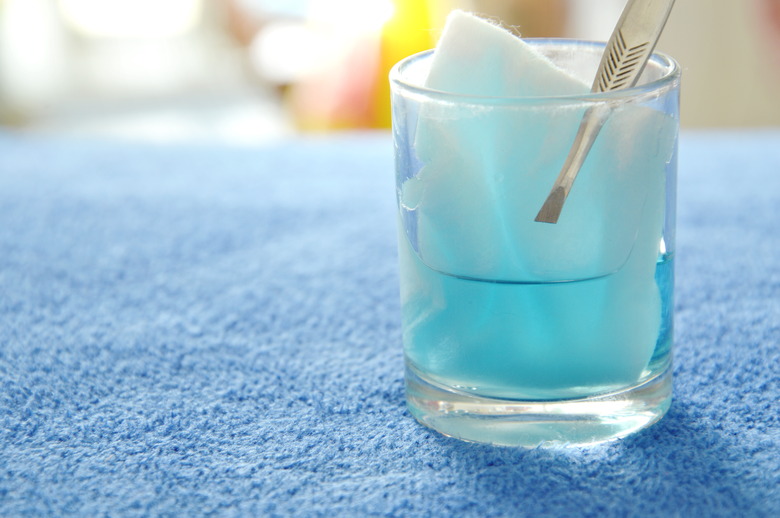Hydrogen Peroxide Experiments
Chemically, hydrogen peroxide has a similar composition to water, except its molecule has an additional oxygen atom. Simple experiments, some of which you can do at home, involve breaking down hydrogen peroxide into water and oxygen, using catalysts to quicken the reaction. Other experiments show the presence of oxygen. Hydrogen peroxide, in combination with other products, can produce visible chemical reactions.
TL;DR (Too Long; Didn't Read)
You can do simple experiments with drugstore hydrogen peroxide at home, breaking it down into water and oxygen.
Hydrogen Peroxide and Yeast
Hydrogen Peroxide and Yeast
Hydrogen peroxide is relatively unstable, so over time it breaks down into water and oxygen. In this experiment, yeast is added to hydrogen peroxide to speed up its decomposition process, which is normally slow. You can perform the experiment at home in a sink. You'll need an empty large soda bottle, 3 percent hydrogen peroxide from a grocery store, one packet of active yeast, liquid dish soap and warm water. Mix about 113 grams (4 ounces) of the hydrogen peroxide with 56 grams (2 ounces) of dish soap in the soda bottle. Set aside and mix the packet of yeast with warm water, letting it sit for about five minutes. Pour the yeast mixture into the soda bottle. The reaction produces oxygen gas and the addition of liquid detergent creates foam.
Hydrogen Peroxide and Bleach
Hydrogen Peroxide and Bleach
The mixture of hydrogen peroxide and bleach creates oxygen gas, salt (sodium chloride) and water. The bleach must contain sodium hypochlorite for this experiment to work. The solutions do not need to be concentrated to get a quick reaction. You will need 3 percent hydrogen peroxide, approximately 6 percent household bleach and a beaker. Pour 56 grams (2 ounces) of bleach into the beaker and the equivalent of hydrogen peroxide. Once the two are mixed, the reaction will occur quickly, producing bubbling.
Hydrogen Peroxide and Burning Sulfur
Hydrogen Peroxide and Burning Sulfur
This experiment doesn't decompose hydrogen peroxide but merely shows that it contains oxygen. You expose a rose to burning sulfur and then dip it in hydrogen peroxide. You'll need two drinking cups, a rose with a small stem, tape, foil, sulfur and hydrogen peroxide. Tape the rose to the inside of the first cup and place a small pile of sulfur on a piece of aluminum foil. Add flame to the sulfur until it starts to smolder — turn the cup with the rose upside down over the burning sulfur. The rose is exposed to sulfur dioxide gas, turning the petals of the rose to white as the gas combines with the oxygen in the colored part of the rose. Remove the rose from the cup and dip it into a cup filled halfway with hydrogen peroxide. The hydrogen peroxide provides oxygen to the flower, restoring its color.
Safety Considerations
Safety Considerations
Make sure to wear protective eyewear when conducting any of these experiments, whether at home or in a classroom or lab setting. If hydrogen peroxide comes in contact with your eyes, it can result in damage or blindness. It is imperative to seek medical attention if this happens. Make sure to wear an apron and clothing that covers your skin. According to the Agency for Toxic Substances and Disease Registry website, hydrogen peroxide can cause skin irritation — there may also be skin burns with blisters with exposure to concentrated solutions. The peroxide you buy in the drug store is typically 3 percent, whereas chemists and other professionals might use stronger concentrations of 35 to 50 percent. Flush your skin with water if it is exposed to hydrogen peroxide.
Cite This Article
MLA
Peralta, Mary Margaret. "Hydrogen Peroxide Experiments" sciencing.com, https://www.sciencing.com/hydrogen-peroxide-experiments-8462947/. 27 April 2018.
APA
Peralta, Mary Margaret. (2018, April 27). Hydrogen Peroxide Experiments. sciencing.com. Retrieved from https://www.sciencing.com/hydrogen-peroxide-experiments-8462947/
Chicago
Peralta, Mary Margaret. Hydrogen Peroxide Experiments last modified August 30, 2022. https://www.sciencing.com/hydrogen-peroxide-experiments-8462947/
